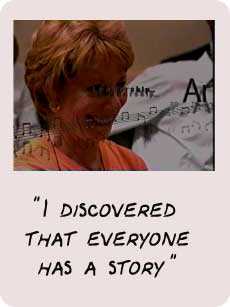|
|
Katalina Groh, Larry Prusak: Some of the world's leading thinkers |
| The film-maker as storyteller: Katalina Groh |
 |
IV.
GETTING TO THE LISTENER’S STORY
Katalina Groh: The HBO executive apologized. He said, “Look, I’m sorry for being so abrupt. I hope you don’t think I’m a jerk.” And I said, “No.” (Laughter) And I didn’t think he was. I couldn’t expect that he was going to have all this time for me, as I would have wanted him to have, because I happened to think that the story was so grippingly interesting. I had to think what he cared about. And what he cared about was, “What am I going to put into the ad for the people who are going to watch this video?” That’s what he cared about. That was his |
| priority. But as
we talked and he asked more questions about this feature film that I’m
working on, it turned out that he had so many personal reasons why he could
identify with the story and the film. The sooner I found those reasons
and we discussed his story, instead of my story, that’s the reason we talked
for over an hour.
That’s the reason why he said, “Oh send it to me when you have a rough cut.” He came and engaged in a conversation that was based on his personal experiences as well, on his personal story. It wasn’t just based on mine. And discovering that with your audience, that’s what we’re always trying to achieve with these films. LESSONS LEARNED FROM MAKING FILMS Some of the discoveries we made about making films. This is an ongoing process. How we make our films now is so different from the way we made our films just a year ago. Some of the best discoveries we made were when we heard comments like, “This doesn’t work because of this.” You’re hearing what’s not working for some reason for somebody. So what’s the barrier? The barriers are what you’re always looking to. So I started out making films that were just entertaining. That became boring to me. We started doing documentary films about nine years ago. Then it became, still entertaining, but with some sort of a message. So that was like the next step. There’s a message in here. That was just a simple next step, some kind of message, learn something new. When I was then making documentaries, and was asked to help launch New World Entertainment’s education division, it was a great challenge. Now we didn’t have 90 minutes to tell the story. Instead I might have 15 minutes, or 17 minutes, or 25 minutes. And it still needed to be entertaining. That was important to me. I could see, watching people watch the film, that at certain points they wouldn’t be paying attention. So it still needed to be entertaining, but it also needed to have a point. It needed to have a “so what?” There had to be an answer to the “so what?” question. EVERYBODY HAS A STORY One of the first discoveries I made was on a film called “Debbie’s Way”. It was a documentary. It was unlike anything else they had seen in the industry. They had given me about twenty tapes, when I started. I liked only two out of the twenty. Most of them, I didn’t like. And both of those two tapes were actually reality based. So they were also real stories. I didn’t know it at the time, but that’s exactly what I liked about these programs. The
first program that we did, the first interviews, meaning interviews for
educational film. What I discovered was that everybody had a story. It
wasn’t the CEO of the company that we were at who had the story. The best
story came from this other obscure person that nobody had really known
would be a really great storyteller. We focused the film on her, because
she was such a natural storyteller. But I discovered that somebody who’s
not saying a lot may actually have the most interesting story.
And so the process of creating the story then changed for us. It didn’t really matter how we started our initial outline, we knew it was going to change a lot. And we had to feel comfortable with that, feel comfortable with saying that we were wrong, and that we were going to lose the whole weekend of work that we had done. That was o.k. Just dump all that and move on. . |
| Books and videos on storytelling *** In Good Company : How Social Capital Makes Organizations Work by Don Cohen, Laurence Prusak (February 2001) Harvard Business School Press *** The Social Life of Information, by John Seely Brown, Paul Duguid (February 2000) Harvard Business School Press *** The Springboard : How Storytelling Ignites Action in Knowledge-Era Organizations by Stephen Denning (October 2000) Butterworth-Heinemann *** The Art of Possibility, a video with Ben and Ros Zander : Groh Publications (February 2001) |
| The views expressed on this website are those of the authors, and not necessarily those of any person or organization |
| Site optimized in 800x600: webmaster CR WEB CONSULTING |
|
|
|
|